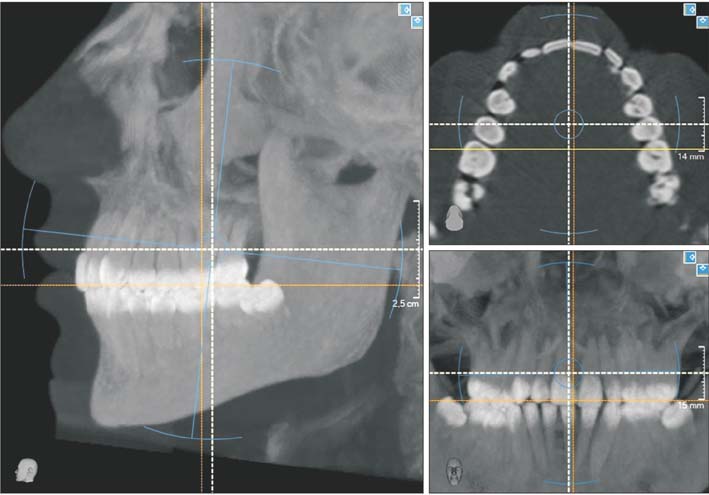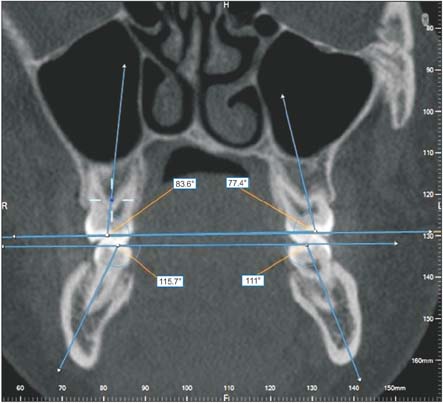Korean J Orthod.
2018 Sep;48(5):333-338. 10.4041/kjod.2018.48.5.333.
Evaluation of buccolingual molar inclinations among different vertical facial types
- Affiliations
-
- 1Department of Orthodontics, Faculty of Dentistry, Yeditepe University, Istanbul, Turkey. dgermec@gmail.com
- 2Department of Orthodontics, Faculty of Dentistry, Marmara University, Istanbul, Turkey.
- KMID: 2421318
- DOI: http://doi.org/10.4041/kjod.2018.48.5.333
Abstract
OBJECTIVE
The aim of this study was to compare the buccolingual inclination of maxillary and mandibular molars in adults with different vertical facial types.
METHODS
Cone-beam computed tomography images of 135 adult patients (age, 20-45 years) with skeletal Class I maxillomandibular relationships were assigned to normodivergent (n = 46), hypodivergent (n = 49), and hyperdivergent groups (n = 40) according to linear and angular sella-nasion/gonion-menton measurements. The normodivergent group consisted of 24 females and 22 males, hypodivergent group of 26 females and 23 males, and hyperdivergent group of 24 females and 16 males. Buccolingual inclination of the maxillary and mandibular first and second molars was measured relative to the occlusal plane. One-way analysis of variance was used for intergroup comparison. Gender differences were evaluated using independent t-tests.
RESULTS
Buccolingual molar inclinations did not differ significantly between females and males (p > 0.05). There were no statistically significant differences among the buccolingual inclinations of the first and second maxillary and mandibular molars of the groups (p > 0.05).
CONCLUSIONS
Buccolingual inclinations of maxillary and mandibular molars are similar in normodivergent, hyperdivergent, and hypodivergent adults with Class I sagittal relationships.
Figure
Reference
-
1. Janson G, Branco NC, Fernandes TM, Sathler R, Garib D, Lauris JR. Influence of orthodontic treatment, midline position, buccal corridor and smile arc on smile attractiveness. Angle Orthod. 2011; 81:153–161.
Article2. Dong JK, Jin TH, Cho HW, Oh SC. The esthetics of the smile: a review of some recent studies. Int J Prosthodont. 1999; 12:9–19.3. Zange SE, Ramos AL, Cuoghi OA, de Mendonça MR, Suguino R. Perceptions of laypersons and orthodontists regarding the buccal corridor in long- and short-face individuals. Angle Orthod. 2011; 81:86–90.
Article4. Gaikwad S, Kaur H, Vaz AC, Singh B, Taneja L, Vinod KS, et al. Influence of smile arc and buccal corridors on facial attractiveness: a cross sectional study. J Clin Diagn Res. 2016; 10:ZC20–ZC23.5. Parrini S, Rossini G, Castroflorio T, Fortini A, Deregibus A, Debernardi C. Laypeople's perceptions of frontal smile esthetics: a systematic review. Am J Orthod Dentofacial Orthop. 2016; 150:740–750.
Article6. Ricketts RM, Roth RH, Chaconas SJ, Schulhof RJ, Engel GA. Introduction to cephalometrics. In : Ricketts RM, Roth RH, Chaconas SJ, editors. Orthodontic diagnosis and planning. Denver: Rocky Mountain/Orthodontics;1982. p. 32–33.7. Andrews LF. The straight-wire appliance, origin, controversy, commentary. J Clin Orthod. 1976; 10:99–114.8. Bennett JC, McLaughlin RP. Orthodontic treatment mechanics and the preadjusted appliance. England: Wolfe Publishing Mosby Year Book;1993.9. Alexander RG. The vari-simplex discipline. Part 1. Concept and appliance design. J Clin Orthod. 1983; 17:380–392.10. Roth RH. Treatment mechanics for the straight-wire appliance. In : Graber LW, Swain BF, editors. Orthodontics, current principles and techniques. St. Louis: CV Mosby;1985. p. 665–716.11. Creekmore TD, Kunik RL. Straight-wire: the next generation. Am J Orthod Dentofacial Orthop. 1993; 104:8–20.12. Shu R, Han X, Wang Y, Xu H, Ai D, Wang L, et al. Comparison of arch width, alveolar width and buccolingual inclination of teeth between Class II division 1 malocclusion and Class I occlusion. Angle Orthod. 2013; 83:246–252.
Article13. Ahn J, Kim SJ, Lee JY, Chung CJ, Kim KH. Transverse dental compensation in relation to sagittal and transverse skeletal discrepancies in skeletal Class III patients. Am J Orthod Dentofacial Orthop. 2017; 151:148–156.
Article14. Tsunori M, Mashita M, Kasai K. Relationship between facial types and tooth and bone characteristics of the mandible obtained by CT scanning. Angle Orthod. 1998; 68:557–562.15. Janson G, Bombonatti R, Cruz KS, Hassunuma CY, Del Santo M Jr. Buccolingual inclinations of posterior teeth in subjects with different facial patterns. Am J Orthod Dentofacial Orthop. 2004; 125:316–322.
Article16. Ross VA, Isaacson RJ, Germane N, Rubenstein LK. Influence of vertical growth pattern on faciolingual inclinations and treatment mechanics. Am J Orthod Dentofacial Orthop. 1990; 98:422–429.
Article17. Masumoto T, Hayashi I, Kawamura A, Tanaka K, Kasai K. Relationships among facial type, buccolingual molar inclination, and cortical bone thickness of the mandible. Eur J Orthod. 2001; 23:15–23.
Article18. Grosso LE, Rutledge M, Rinchuse DJ, Smith D, Zullo T. Buccolingual inclinations of maxillary and mandibular first molars in relation to facial pattern. Orthod Pract. 2012; 5:43–48.19. Nouri M, Abdi AH, Farzan A, Mokhtarpour F, Baghban AA. Measurement of the buccolingual inclination of teeth: manual technique vs 3-dimensional software. Am J Orthod Dentofacial Orthop. 2014; 146:522–529.
Article20. Riedel RA. The relation of maxillary structures to cranium in malocclusion and in normal occlusion. Angle Orthod. 1952; 22:142–145.21. Horn AJ. Facial height index. Am J Orthod Dentofacial Orthop. 1992; 102:180–186.
Article22. Okada E. Three-dimensional facial simulations and measurements: changes of facial contour and units associated with facial expression. J Craniofac Surg. 2001; 12:167–174.
Article
- Full Text Links
- Actions
-
Cited
- CITED
-
- Close
- Share
- Similar articles
-
- A study on the pre-eruptive positional change of the lower third molar following orthodontic treatment
- Positional relationship between mandibular third molar and mandibular canal in cone beam computed tomographs
- On cephalometric study of axial inclinations in relations to the malocclusion types
- A comparative study of pre- and post-treatment cephalometric measurements : extraction vs. non-extraction groups of Class I malocclusion
- Evaluation of factors influencing the change of vertical dimension of face after orthodontic treatment



